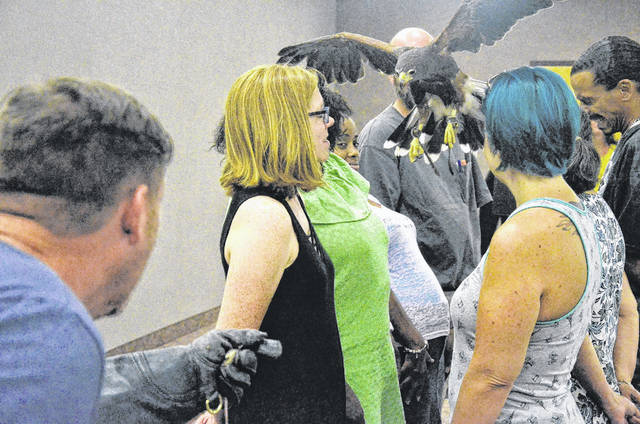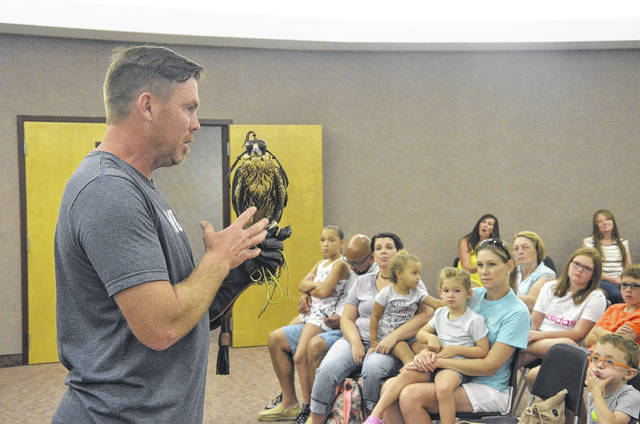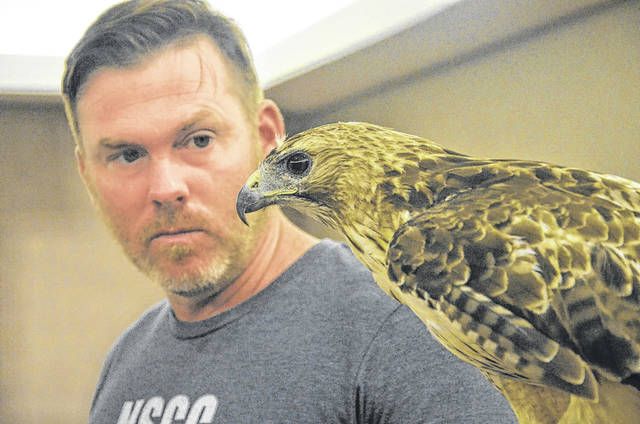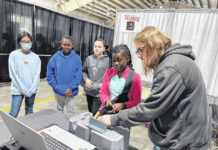LUMBERTON — More than 100 people got schooled Friday on birds who hunt to survive and once were pets to European nobility.
Master falconer Chip Gentry brought his traveling entertainment and educational event about falcons, hawks, and owls to Osterneck Auditorium in Lumberton.
“It gives children something up close to see,” Gentry said. “Ordinarily, they wouldn’t get a chance.”
Falconry is the oldest sport in history, going back 5,000 years, he said. The sport of hunting with birds started long before the use of guns or bows and arrows.
“The idea is to educate children, where the birds are in the chain of life,” said Lisa Bowden, Youth Services librarian with the Robeson County Public Library. “Children don’t see birds of prey very often, so our goal is to share their role in the environment, to share their importance. They are necessary in the chain of life.”
The Robeson County Public Library in Lumberton created the event as part of its summer series to show that the library offers more than books.
“Children here really respond well to animals. They are the way to go at any age,” Bowden said.
The idea for a birds of prey program came from the network of librarians in the state.
“They share ideas, and chose this based on happenings at other libraries,” Bowden said.
The Harnett County library in Lillington had a presentation by Gentry, and it turned out to be one of its most successful events ever.
“We had over 300 people come,” said Autumn Landers, Youth Services librarian. “They were excited to see and learn about the birds found near here and their habitats. The animals are used for hunting, and they are important to the local ecosystem, taking care of field mice and other rodents. We’d be overrun without them.”
“If they were wiped out, in three months we would have a disaster,” Gentry said. “They help keep the environment in check.”
Birds of prey, or raptors, have four main physical characteristics that are different from the ordinary bird, such as a pigeon.
“The raptor has forward set eyeballs,” Gentry said. “They are looking forward all the time, and not worrying about the back. They have a hooked beak to tear meat. The birds have talons, with strength to capture their prey. Meat is their primary source of energy, but this can be from grasshoppers to small deer.”
During Friday’s show, Gentry set up a group of eight audience members in a line that would be similar to a forest. Then he called a Harris hawk to fly through the group to feed on a mouse in his hand.
As the hawk flew through the group, the members felt the air from the wings brushing their hair, and even being hit by a wing.
“I felt safe today,” said Carlotta Graham, a member of the group. “But I wouldn’t do it by myself.”
“I wanted to be brave in front of my kids,” said Quadi Strickland, another group member. “I learned a lot today, about their small brains and big eyes.”
“Incredible eyesight is part of the package as well,” Gentry said. “Vision for a raptor is 10 times as sensitive as that of a human being. They have ultra-violet and binocular vision as well. If you placed a can of Coke on the road and walked away from it until you couldn’t see it, a raptor could see it from 10 times that distance.”
Audience member Joyce Bennett was amazed at the relationship between the birds and Gentry.
“They really understood him,” she said. “I didn’t think they had a bond as close as that of your average pet. It was an amazing talk.”
“I thought it was awesome to have live birds,” said Tony Mili, another audience member. “It was educational to learn about them, to see how they work to sneak up on prey.”
Ten-year-old Jeffrey Jackson II wants to be either a marine biologist or zookeeper when he grows up.
“I was fascinated by them, their abilities, how they hunt and soar,” he said. “The barn owls scan the cornfield for prey. The falcon is such an agile flier, too.”
Gentry said his is a unique job, one that he created for himself. He offers hunts with his birds, and is licensed to reduce nuisance bird populations, such as starlings from airports and farms, as part of his company, Hawk Manor, in Lillington.
Gentry got started in the field by chance.
”I had my own pet store, and I went hunting with a customer,” he said. “I was hooked.”








